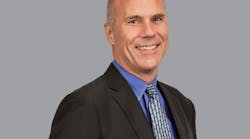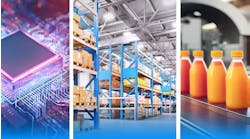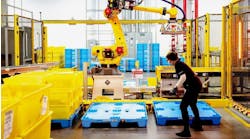Earlier this year, Mark Bulanda was named Emerson Automation Solutions’ executive president, where he oversees an $11.2 billion business that helps some of the world’s leading companies leverage automation software and technologies to optimize operations, protect personnel and reach sustainability targets.
Since we always appreciate perspective from those adopting new leadership roles in this automation space, we posed a few questions to Mark about sustainability, hydrogen production and the circular economy. Take a look…
Smart Industry: What has most surprised you in your (relatively) new role? What is the biggest challenge you face? What is a cause for optimism?
Mark: I’ve been with Emerson since 1985 and worked across the entire automation business, so not much has surprised me. But I think our biggest challenge right now is the pace at which our world is changing—and companies like ours as well as our customers must be agile and respond. There is a critical urgency to move faster on sustainability initiatives than ever before—regulations are shifting and incredibly varied across different markets.
Because of COVID, people are working in new and different ways. Dramatic weather events are putting incredible pressures on industries. I could go on. Technology and automation are key to adapting to all these things—and that’s why I’m optimistic. We have an incredible opportunity—and we have the solutions and expertise ready—to help our customers transform their operations in a way that’s right for them and helps them not only adapt quickly and meet sustainability goals, but also find efficiencies and performance success that they haven’t experienced before.
Smart Industry: Sustainability is a focus for you. What does sustainability mean to you at this stage of industrial digital transformation?
Mark: Sustainability is a major priority in our world right now, for good reason. We’re seeing more and more customers set sustainability targets and implement responsible solutions, while also needing to adhere to changing environmental regulations around the world. Sustainability also means adapting operations to implement new capabilities—like renewables—and ensure reliability in the most challenging conditions, like natural disasters and other weather events that put pressure on essential industries.
Implementation of new technology and creating efficiencies with existing tech is often the answer to all these objectives. Our Automation Solutions business has continually helped some of the most critical industries around the world—including power and energy, oil and gas, life sciences, food and water—optimize their production processes to operate safely and reliably. These same technologies and expertise, along with new software and analytics, are helping customers find efficiencies, increase reliability, optimize energy, lower emissions and reduce the overall environmental impacts of their businesses.
Beyond being good for the world, customers are finding that sustainability efforts are also good business. The actions they take to reduce emissions and optimize their own energy consumption means lowering their cost of operations and extracting greater value of resources. Lastly, sustainability is fueling tremendous innovation. Imagination is being unleashed to solve these big global problems, and part of our responsibility is to help scale these solutions up and out to industry.
Smart Industry: Explain your focus on optimizing hydrogen production along the chain.
Mark: As governments around the world require cleaner energy alternatives amid a growing climate crisis, hydrogen is emerging as a potential alternative to today’s fossil fuels. From upstream hydrogen production, to midstream storage and distribution, to downstream consumption, Emerson technologies are helping accelerate the development and scalability of the entire hydrogen chain.
Our technologies are helping the industry safely produce, store, move and use hydrogen in many ways. We are well positioned with our product portfolio, software and Plantweb digital ecosystem, as well as engineering capabilities and project-execution expertise, to help hydrogen customers lower costs, optimize production and, most importantly, scale their operations as the industry matures.
Hydrogen isn’t new, but innovation is making the promise of scalability possible. The world is learning how to incorporate hydrogen into the energy mix and we get smarter every day.
We are working with a range of customers—from established companies to new start-ups—as well as research partners to deliver automation technologies to hydrogen projects to help prove new production processes and business models for the industry. It’s an exciting time, for sure.
Smart Industry: What does it mean to "build a smarter grid" and what will a smarter grid enable?
Mark: An enormous change is underway as utilities are investing to digitize the grid. Digitalization is critical for the power industry to modernize and improve the reliability of the electric grid, adapt to rapidly evolving energy sources and increase consumer choices. The goal of a smarter grid is to enable power producers to monitor, control and optimize real-time operations across the power enterprise through scalable, software-enabled automation and data management.
Many utilities, for example, are incorporating clean and renewable energy sources, such as solar and wind. The introduction of distributed energy resources, such as rooftop solar, plug-in electric vehicles, demand response and energy storage are further altering the grid as we know it today.
Our software and technologies are helping power producers address the transformational challenges of the electrical system through real-time management of renewable energy variability and the bi-directional demands of distributed energy resources, resulting in a more sustainable, environmentally friendly and reliable grid. We’re also working with power and energy companies, implementing technology and software upgrades to help them prepare for devastating weather events by automating load shedding, maintaining grid frequency, forecasting load demand and managing planned and unplanned outages.
Power generators and consumers will benefit from a smarter grid that embraces modern technology and end-to-end integration.
Smart Industry: What do you mean by a "circular economy" and what gains are available there?
Mark: There are many opportunities in the circular economy, specifically to recycle and reuse existing products and/or to turn them into brand new products—all with the goal of using less of our valuable resources and reducing waste. The emergence of carbon capture, utilization and storage helps us not only contain carbon-based emissions, but also actually convert them into useful resources like hydrogen.
We also play a big role in the circular economy of plastics, for example. Currently, we are working with a company to automate their new recycling facilities that will purify waste plastic to create near-virgin polypropylene to be used in new applications. Another customer is using high-pressure steam to take what has been classified as “unrecyclable” plastics and convert them into raw ingredients for a circular-plastics economy. These new processes rely on advanced automation technology and software to create advanced production models that can be scaled.
Smart Industry: What most excites you about the near future of automation in the manufacturing space?
Mark: Automation, traditionally focused on optimizing production processes, is unquestionably one of the critical tools that our customers can use to meet their sustainability goals. So many companies have set bold 2050 targets. While these targets are a generation away, there is a sense of urgency to start showing progress now. Every decarbonization move we make today and tomorrow is a learning opportunity. Progressive companies have a “learn fast and improve” mentality. This mentality, of course, has inherent risk, so they must be smart in their execution, but the greater risk is to move slowly.
Our automation software and technology can help companies achieve small wins that provide measurable results and key learnings that show progress toward meeting their sustainability goals and, most importantly, the ability to scale for maximum results. And we can help lower the inherent risks as our customers hunt for the best bets to target.
We know automation innovation plays a critical role in meeting sustainability initiatives like low-carbon fuels, emissions prevention, energy and resource efficiency, and the circular economy, but the call for urgency is upon us. The challenge is to work faster in leveraging automation for a better world.
I’m excited to see how innovative ideas are being translated into real solutions, coming to market faster than ever before to support the world’s sustainability commitment.


